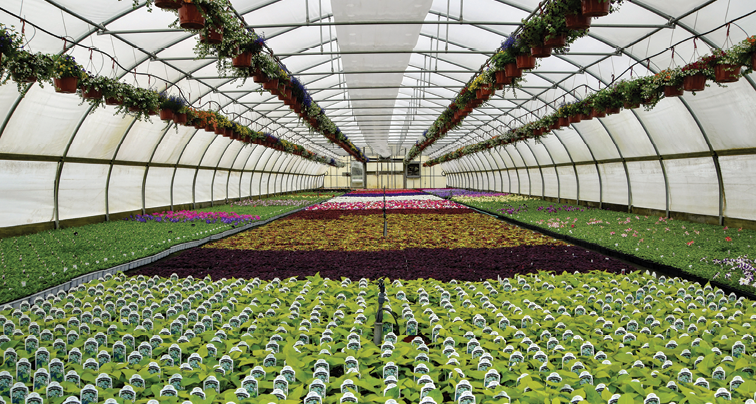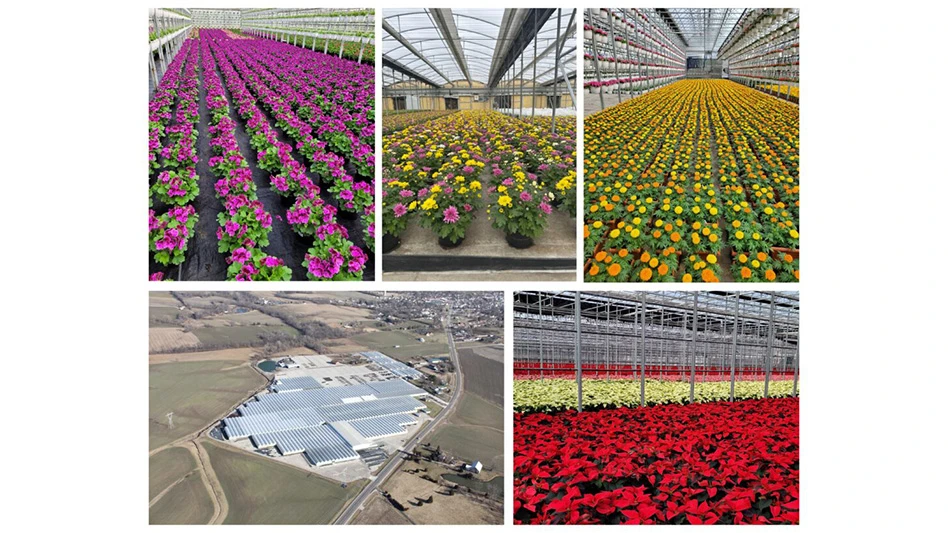
As the spring season approaches, greenhouse growers face the intricate challenge of managing a diverse array of crops, each with its own unique environmental and cultural requirements. But there are effective strategies for grouping greenhouse crops to optimize growing conditions, enhance plant quality and boost overall productivity. By implementing these strategic grouping techniques, growers can navigate the complexities of growing various plant species side by side, ensuring success in their greenhouse operations during the spring production period.
Temperature management
This is a fundamental strategy for greenhouse crop grouping. Plants can be categorized into three temperature-response groups: cold-tolerant (base temperature below 40 °F), cold-temperate (base temperature 40 to 45 °F) and cold-sensitive (base temperature above 45 °F). Ideally, crops should be separated based on their base temperature and grown in greenhouses with different temperature set points. This approach can optimize crop scheduling, reduce heating costs and maintain crop quality. However, it may not be feasible for all operations due to space constraints and environmental control limitations.
Light management
This is another consideration for greenhouse crop grouping. Crops can be grouped according to their photosynthetic daily light integral (DLI) requirements or the integrated measurement of light intensity and photoperiod that plants receive over the course of the day (24-hour period). Under low DLIs, growers may deploy supplemental lighting or remove shade, while high DLIs might prompt the use of shade curtains or external shading compounds. Greenhouse environmental control systems can automate this process by setting light thresholds that trigger lighting and shading adjustments based on outdoor conditions. While grouping crops by their photosynthetic DLI requirements can be advantageous for managing light conditions and maintaining crop quality, it may not be feasible for all operations. This approach may not be optimal for greenhouse operations without horticultural lamps, shade curtains, environmental control systems with the capability of controlling lighting and shading, or equipment to measure and monitor photosynthetic DLI. As a result, the practicality of DLI-based crop grouping often depends on the technological capabilities of individual greenhouse facilities.
Substrate pH management
Managing pH is a critical aspect of crop grouping. Plants can be categorized into three groups based on pH preference: iron-inefficient (pH 5.5 to 5.8), general (pH 5.8 to 6.2) and iron-efficient (pH 6.2 to 6.5). Monitoring and managing the appropriate pH levels for each group is essential to prevent nutritional disorders. Iron-inefficient crops are susceptible to iron deficiency at high substrate pH, while iron-efficient crops may develop iron and manganese toxicity at low substrate pH. Growers should regularly monitor substrate pH and implement corrective measures.
Fertilizer nitrogen rate
Crops can be grouped based on their nitrogen requirements, often referred to as “hunger” or “feeder” categories. Light feeders typically require 50 to 75 ppm N, moderate feeders 100 to 200 ppm N and heavy feeders 200 to 300 ppm N. It’s critical to monitor substrate electrical conductivity (EC) to ensure proper fertility levels. Many growers are now adopting “growing lean” practices, using lower nitrogen concentrations to reduce costs and environmental impact while maintaining plant quality. This approach requires careful management and regular monitoring of plant health and nutrient status.
Mastering the art of crop grouping is essential for successful greenhouse management and requires a comprehensive and adaptable approach. Growers should carefully assess their greenhouse layout and environmental control capabilities, prioritizing grouping criteria based on their specific crops and facilities.
Regular monitoring of plant health and environmental conditions is crucial, as crop requirements may change throughout the growing season. By considering temperature, light, substrate pH and fertility requirements, growers can create tailored greenhouses or sections that meet the specific needs of their diverse crop selection.
This strategic approach to crop grouping allows for the optimization of growing conditions within greenhouses, resulting in improved plant quality, reduced resource waste and increased overall productivity. Ultimately, this method not only enhances plant quality but also improves resource efficiency and operational success throughout the spring production season.
This article appeared in the February 2025 issue of Greenhouse Management magazine under the headline "The art of strategic crop grouping."

Explore the February 2025 Issue
Check out more from this issue and find your next story to read.
Latest from Greenhouse Management
- Terra Nova Nurseries introduces rust-free and disease-resistant heucherella
- John T. Nickel, founder of Greenleaf Nursery Co., passes away at 89
- Three tours offered at 2025 Farwest Show
- Garden Media Group announces sixth annual Women in Horticulture Week
- Star Roses and Plants announces National Knock Out Rose Day
- The Growth Industry Episode 4: How federal budget cuts are affecting horticulture nonprofits
- The thrips battle plan
- Pennsylvania Horticultural Society shares top gardening trends from 2025 Philadelphia Flower Show





